- Editorial Offices
- 325 Brantly Hall
- Missoula, MT 59812
- (406) 243-2488
- themontanan@umontana.edu
- Icons By Maria Maldonado
Legendary coach Robin Selvig calls it quits after nearly four decades with Lady Griz
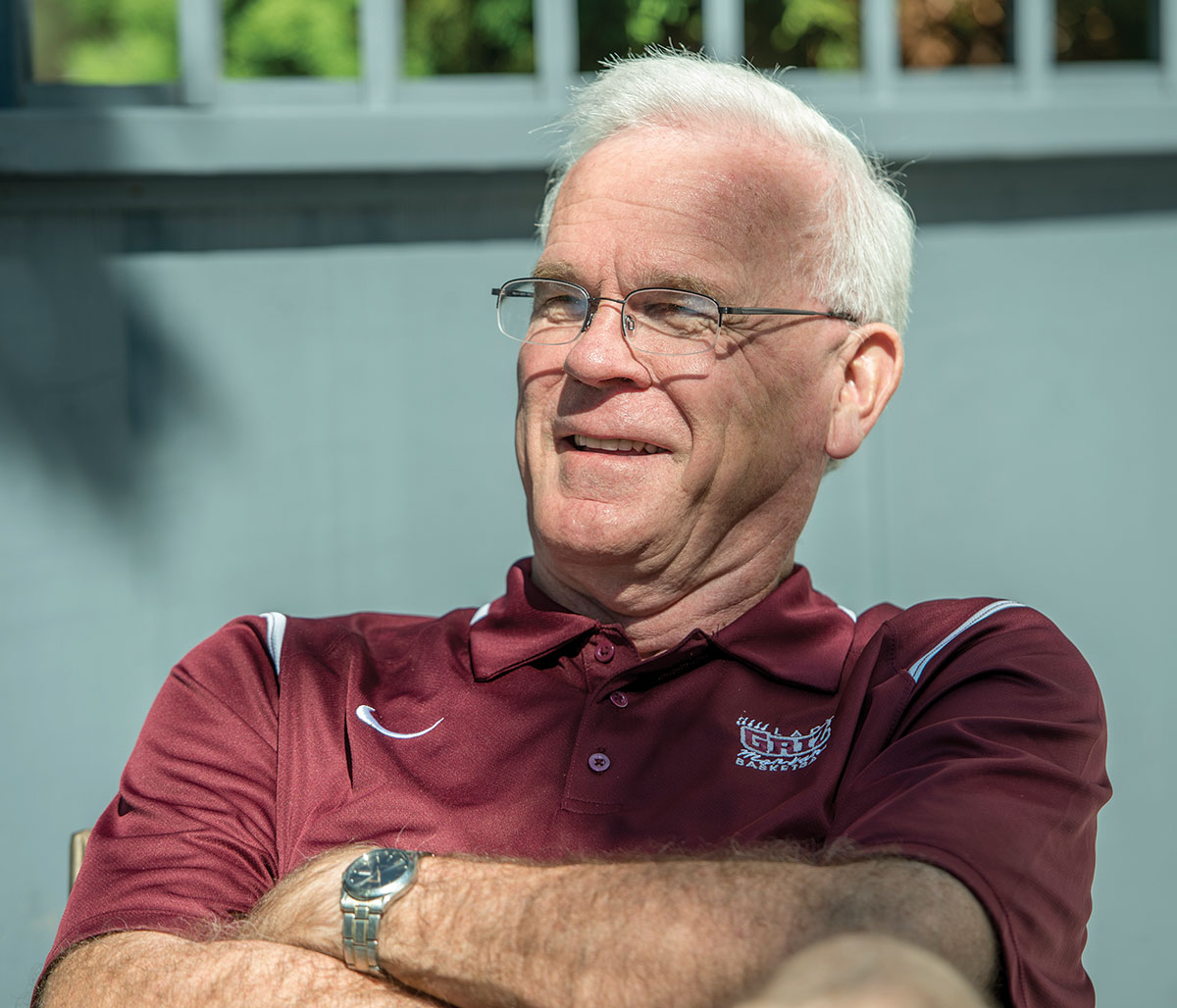
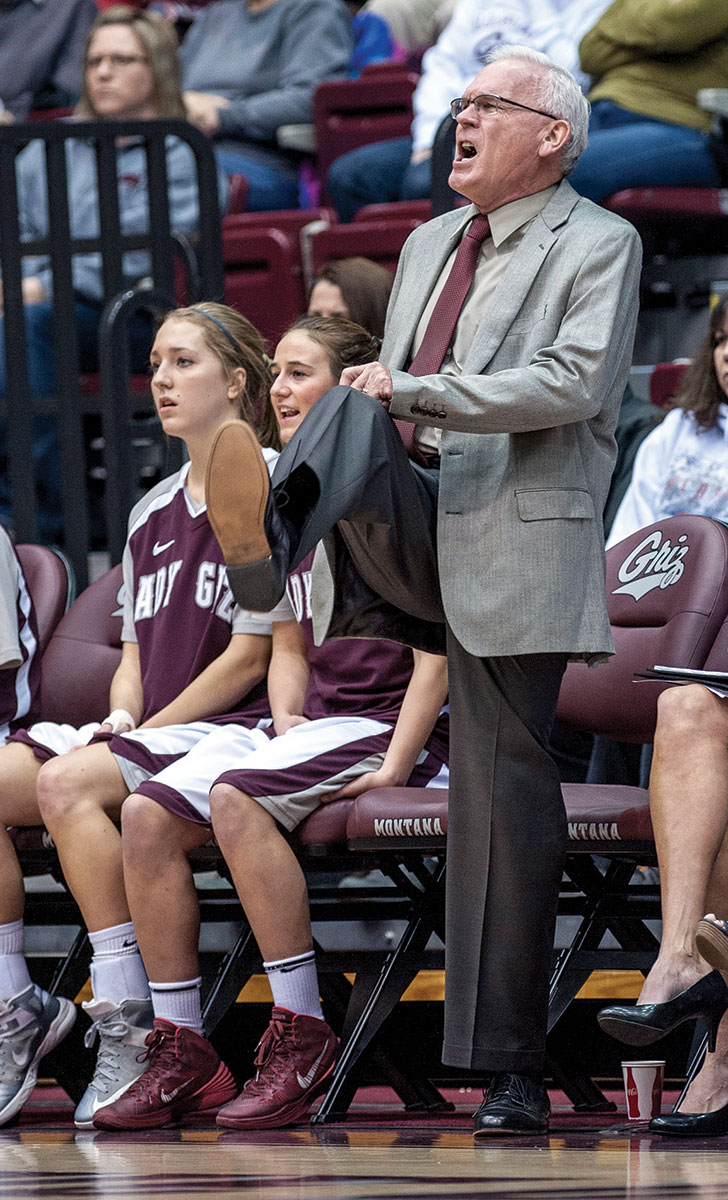
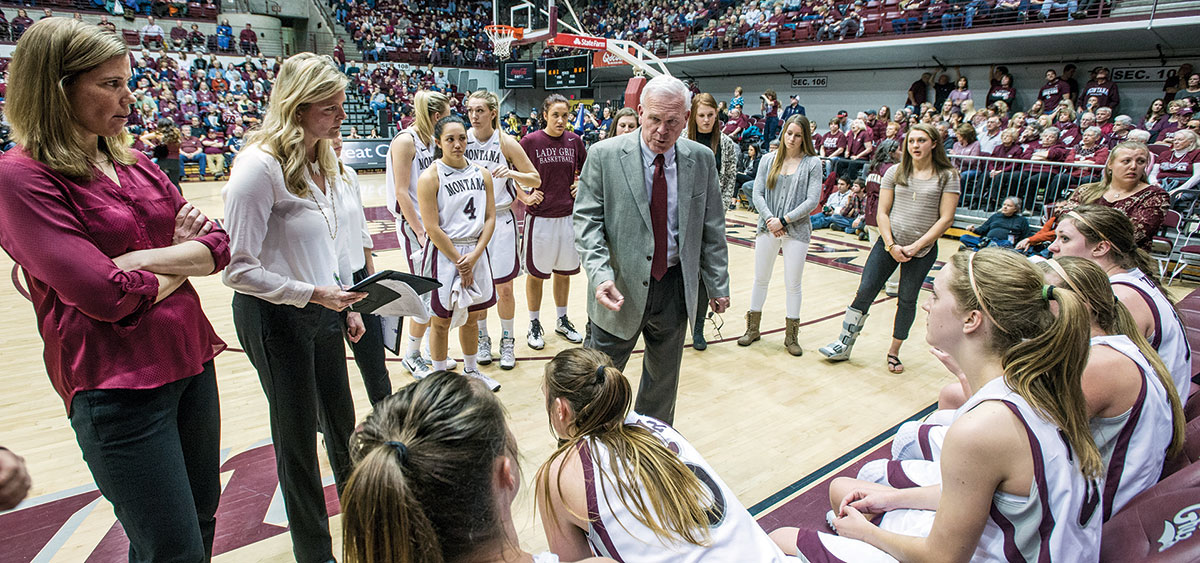

From Anderson to Williams, Whitaker to Austin, Robin Selvig saw a wide range of young women come through his Lady Griz basketball program. Scorers, rebounders, passers and defenders.
Meanwhile, all of them – or at least 99 percent of them – traced very similar paths, playing at the University of Montana for one demanding, demonstrative coach.
And it was amazing.
“I loved playing for Rob,” says Shannon Schweyen, who on Aug. 11 was named head coach of the Lady Griz program that Selvig led for 38 seasons. “He had a way of making you leave it out there. You knew he was never satisfied, so you just played super hard for him.”
Thirty-one times his teams won at least 20 games in a season. The Lady Griz took first in 17 Big Sky Conference tournaments. The numbers, as impressive as they are, don’t tell the full measure of his impact.
“When the team would lose and you’d expect him to come in and rant and rave, instead he’d come in and cry with the team,” says Schweyen, his top recruit and best player. “Didn’t expect that.
“And he’s brilliant,” she says. “I look back at what he did in my career, putting me in spots where was I was able to be successful, and he was just a mastermind. I was able to use my abilities to my utmost, really.”
Montana’s lone Kodak All-American wasn’t alone. Dozens upon dozens of players came through Missoula, where their coach sought to use their talent, bring out their best and win. Which the Lady Griz did, 865 times.
“All these girls who played under him had the same experience,” marvels Krista Redpath Pyron, a Lady Griz from 1995-2000. “That’s going to be a big change.”
The Lady Griz have been stunningly consistent, the product of a coach who balanced knowledge and passion – and added a bit of superstition.
“In the afternoon before games, I get in my car and I drive up the Rattlesnake,” Selvig began, at his retirement press conference on July 27. He explained how he’d sit near the trailhead, listening to whatever CD he had that season – “I stepped it up a little this year with Adele,” he says – and try to relax.
“It’s just a game,” he says. “Don’t go crazy. You can see how well that worked for me. But I did that routine today, just for old time’s sake…”
Then Selvig stops. He’s crying. Again.
Selvig came to Missoula out of the northeastern Montana hamlet of Outlook, a town that’s shrunk since the days he put up games of 48 and 39 points at the 1970 State C tournament. A review of the Bluejays’ league that year – Flaxville, Antelope, Westby, Medicine Lake, Lustre Christian, Outlook itself – reveals that most of the towns no longer have their own high schools.
Selvig was a track star on a two-man team that won the state title in 1970, which was a feat in itself. He ran his best hurdles times at state in Missoula and credits his future college basketball coach, Lou Rocheleau, for giving him a few tips at the meet.
“Well, we only had one hurdle in Outlook,” Selvig says. “That’s the truth.”
Rocheleau was destined to be UM’s head coach just two seasons, and his last was Selvig’s first year, when freshmen were still ineligible under NCAA rules. Then Jud Heathcote took over.
“Jud came in my sophomore year, and it was…” Selvig pauses. “It was a great thing. At the time it was hard for everybody. But he got basketball going at this place.”
Rocheleau had been replaced by a taskmaster. It was 1971, and the players didn’t know what hit them.
“Unless you played for him and understood, he was very – from the outside looking in – very tough,” Selvig says. “I think for a while I couldn’t even dribble. I was practically in a depression.
“Every practice of Jud’s was a happening. There was tremendous intensity all the time. He was an in-your-face, it-seemed-personal-at-the-time coach. But once you figured out what it was all about, once you made the grade, it was fine.”
Four decades later, Heathcote, who retired from Michigan State in 1996 after 19 seasons – which included a Magic Johnson-led national title in 1979 – says Selvig could have gone on to the next level.
“I thought if he hadn’t hurt his knee he could have played professional basketball,” Heathcote says from his home in Spokane, Washington. “He had a great sense for the game and was a very talented player. Then he hurt his knee, and he was never speedy before, but he lost about half a step.”
Another thing: “When I took the job, he’d had a year here,” Heathcote says. “Jim Brandenburg told me, ‘I don’t know if we should keep Robin. He’s very good offensively and very, very poor defensively.’”
That quickly changed, Heathcote says. Selvig “suddenly becomes the toughest player on the team.”
“He was a great coach, and is a great person,” Selvig says. “As a coach I’m glad I got three years with him. He’s a great teacher. He broke things down in a way that made sense.
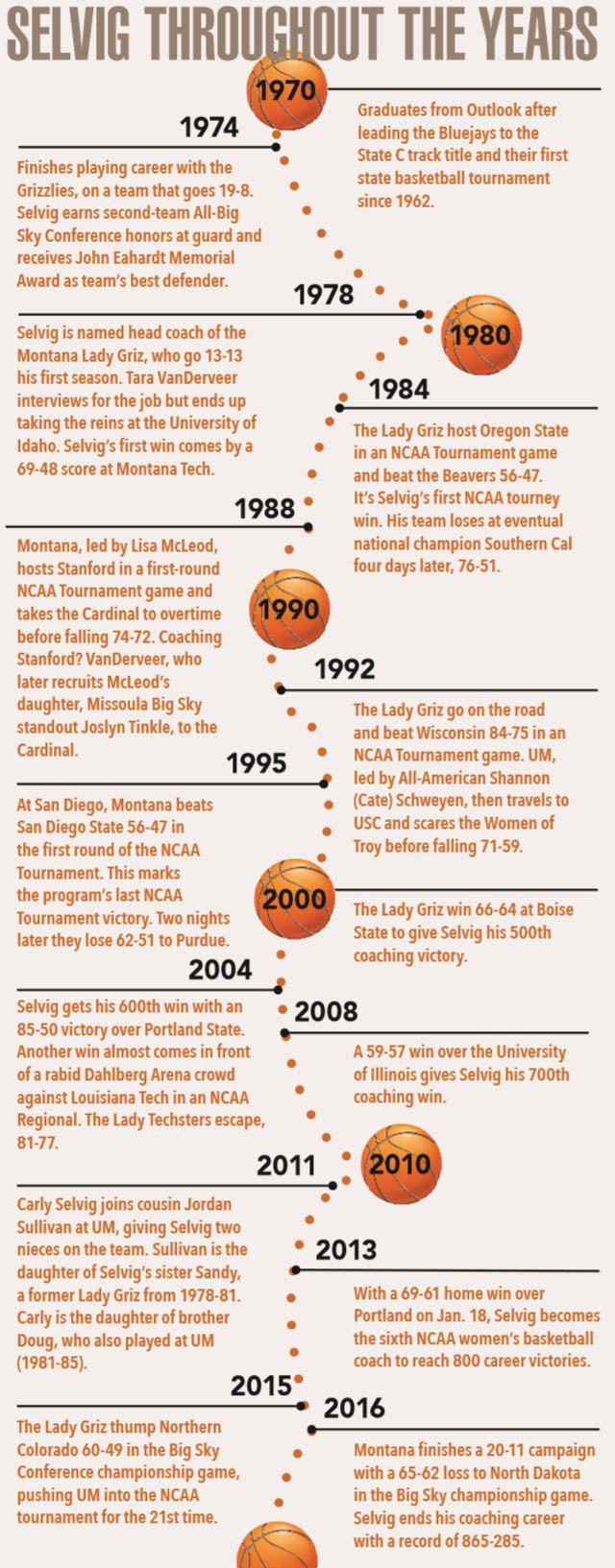

“Apparently I didn’t know anything about defense when I got here. And I didn’t know I wasn’t tough at all. And I didn’t know I played like a girl – which now I consider a great compliment.”
Selvig was the Grizzlies’ freshman coach in 1974-75, the season the men nearly knocked off eventual champion UCLA at the NCAA Tournament. The next year he was in Plentywood, where he took a teaching job with the idea of coaching the Wildcats’ boys’ basketball team.
Instead, longtime and legendary coach Zoonie McLean stayed on, partly because he had a great team coming back. He did – the Wildcats won the 1976 State A title.
So Plentywood’s superintendent asked Selvig if he would be head coach of the school’s fledgling girls’ basketball team.
This is how it all really began.
“They won one game the year before,” Selvig notes. “It ended up being a pretty good break for me. I took them seriously and – this is my opinion – they liked that. I coached them just like college guys, I mean – I just coached them.”
Girls’ basketball really was in its early stages as an MHSA sport, but it was burgeoning. He coached the Wildcats to winning records his first two years, while Plentywood was Class A’s smallest school. The next year, Plentywood dropped a classification and made it to the 1977 State B tournament, finishing fourth.
That following spring – girls’ basketball was played in the fall until 2002 – UM had an opening for a women’s basketball coach.
It is hard now to imagine a different outcome, though Selvig did at the time. In the end he and his high school sweetheart, wife Janie, loved Missoula. He left one fledgling team for another.
He was 25. Mike Montgomery, then the men’s basketball coach at UM, was Selvig’s superior. Montana played the other Big Sky Conference schools, but the league called itself the Northwest Women’s Basketball League and then the Mountain West Athletic before the Big Sky took command in 1988.
“This day and age you don’t get a college job that young, but it was just getting started,” Selvig says. “I almost didn’t pursue it because I had a pretty good team coming back in Plentywood, and women’s basketball was no sure thing in college.”
Basketball was basketball, no matter who played it. Selvig wished better for his oldest sisters. All four of his brothers played some form of college basketball, but Diane didn’t get to play even high school hoops, and Kari barely did, once the MHSA sanctioned girls’ basketball in 1972.
“It’s really sick to think that women didn’t have these opportunities before,” he says. “It just didn’t make sense. I was glad to be in it, because in those days they were so thankful to have the opportunity.”
Sandy, the youngest sister, got four years of high school ball, then two years at Flathead Valley Community College and became one of Selvig’s first recruits at UM.
“She had to go somewhere,” he cracks, and notes that two of his first phone calls went to players he saw at the 1977 State B girls’ tournament: Harlowton’s Janie (Glennie) Carlson and Vicki (Heebner) Carle of Three Forks.
“I didn’t get either one of them,” he adds.
Both went to Montana State, but this was a sign that he could scoop plenty of talent right here in the Treasure State. Even if some stayed beyond his reach.
"Apparently I didn’t know anything about defense when I got here. And I didn’t know I wasn’t tough at all. And I didn’t know I played like a girl – which now I consider a great compliment."
Coach Robin Selvig
“One thing about recruiting: You get rejected,” Selvig continues. “You have to reject some people. Those things are all hard for me. When we lost great players, which we’ve lost a number of them, I always looked at who we got instead and loved them, and they were great Lady Griz. “There were no regrets after the fact. If I’d gotten one of those players then I wouldn’t have this other one.”
The recruits he landed got the full breadth of Selvig’s knowledge, gleaned from playing for Lew Rogers in high school and then Heathcote. His practices may not have been the pressure cookers Heathcote created, but his sideline demeanor gave his former coach a run.
Schweyen, who joined his staff in 1993, noted the price paid by Selvig’s corrective lenses.
“I think over the years we’ve had to repair several pairs of glasses,” she says. “Our trainer carried a little kit.”
His language turned blue, though he often tried to direct what he said at his staff.
“What kind of doohickey (expletive) pass was that?” he’d ask, and his assistants, all former players, would look at each other and mouth, “Doohickey?”
Call it Selvig’s unintentional ode to Heathcote. He doesn’t feel great about it.
“There’s just a level of intensity that goes with it when the ball goes up,” Selvig says. “(Heathcote) was better than I and better than most at having that same level in practice. I certainly had it during games, and I think my ladies had it during the games as a team.”
There were only a couple years where the Lady Griz didn’t post a winning record. The 1997-98 team stands out for its struggles, and how Selvig stayed the course.
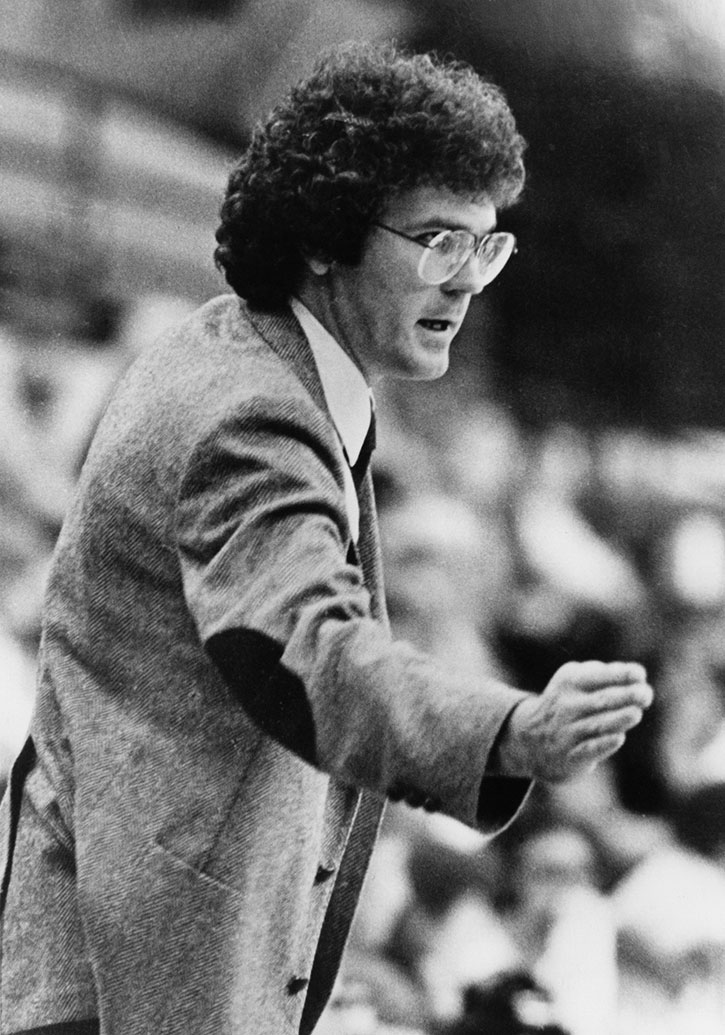 Skyla Sisco had graduated, and a host of Lady Griz were injured: Lauren Cooper (foot) in the offseason, Pyron (knee) on the eve of the first game and Megan Harrington (knee) during one of the Griz-Cat games. Meanwhile, games were played at Missoula Sentinel High School’s gym while Dahlberg Arena was remodeled. The squad started 7-13 and ended up 12-16 with a loss in the Big Sky semifinals.
Skyla Sisco had graduated, and a host of Lady Griz were injured: Lauren Cooper (foot) in the offseason, Pyron (knee) on the eve of the first game and Megan Harrington (knee) during one of the Griz-Cat games. Meanwhile, games were played at Missoula Sentinel High School’s gym while Dahlberg Arena was remodeled. The squad started 7-13 and ended up 12-16 with a loss in the Big Sky semifinals.
“I don’t count that year,” Pyron says.
“That was the first year I had seen or remember having a losing season,” adds Linda Weyler Jacobson, a cornerstone on that team. “It could have been worse – we could have lost more games. All the coaches – I don’t remember losing a game and not wanting to play again – took every loss and made sure we were going to play as hard as we could.”
The next year the Lady Griz went 22-8, winning the Big Sky regular-season and tournament titles. Another NCAA bid, one of 21, followed.
“There is something about him, to get the number of quality girls and get them every year to consistently play at such a high caliber,” Jacobson says. “Why wouldn’t you want to play for him, if you’re from Montana? Really?”
Jacobson grew up in Billings, watched Schweyen play at Billings Central and listened to Lady Griz games on the radio. Then she was a star herself at Billings Senior.
“It was kind of a surprise when he called me,” she says. “I was like, ‘I need to ask my parents and call you back.’ He said, ‘Sure.’
“They said yes.”
So it went, player after player, year after year. They came, played and graduated. Selvig stayed.
“I offered him a job at Michigan State twice, and he turned me down both times,” Heathcote says.
Bill Moos, the athletic director at Washington State who held the same position at UM, says he thought of calling Selvig while at Oregon, when the Ducks needed a women’s coach.
“I actually did,” he says. “But I knew that he’d had other opportunities and had turned them down. That’s one of the things I admired about Robin.”
“I don’t know – I’ve never approached it as if there were any differences (between the men’s and women’s teams),” Selvig says. “I like coaching. I like players who want to be their best and play together. So I didn’t need anything else.”
In Selvig’s 38 years with the Lady Griz, Montana changed men’s basketball coaches seven times.
“There was talk,” he allows. “But it never even entered my mind that it would happen. I’m going to tell my team, ‘I’m moving up to the men?’ I never thought it was moving up.”
Tara VanDerveer, who guided Stanford to an NCAA title and is heading into her 32nd season coaching the Cardinal, interviewed for the UM job Selvig got in 1978. One wonders how things might have been different.
“For somebody to have that longevity and legacy,” she says. “Women’s basketball will miss Robin, and he’s a first-class coach.”
As the accolades and testimonials continue to come in from former players, Selvig is, it seems, satisfied. He’ll go to Lady Griz games, he says, but he’ll sit far away from the bench. Schweyen doesn’t need a helicopter former coach.
“It’s going to be their deal, as it should be,” he says. “And I don’t want to make decisions anymore. Someone else can make the decisions.”
VanDerveer, who like Selvig is 63, wonders what that might be like.
“There’s a side of me that’s jealous,” she admits. “I love what I do, but I give him credit for being able to step away. Coaching is a little bit addictive. You love it, but there’s a part of you that wonders what you do without it.
“I’ll have to give him a call in the middle of winter and see how he’s doing.”